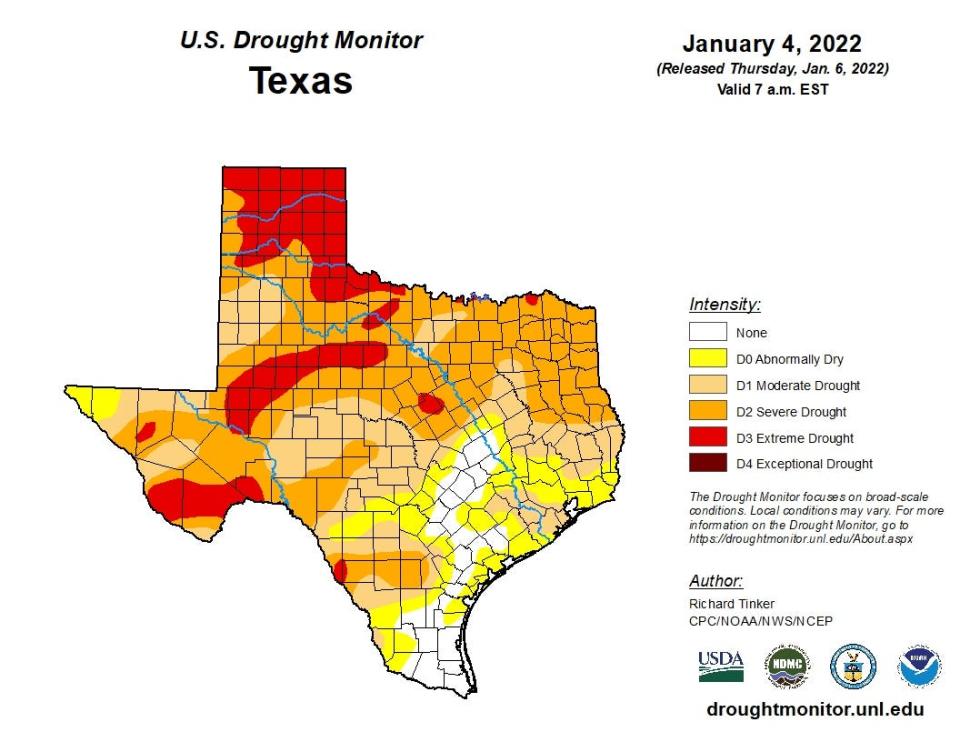Snow ended Amarillo's 80-day streak of zero precipitation. It didn't stop the drought.

The latest snowfall on Saturday, Jan. 1, ended the 80-day stretch of no precipitation in the Amarillo area, but it did not end the drought.
According to Michael Gittinger, acting meteorologist in charge for the National Weather Service office in Amarillo, the first snowfall of 2022 ended the streak of 80 consecutive days without any measurable precipitation, the second-longest streak in Amarillo on record.
According to the U.S. Drought Monitor, most of the Texas Panhandle, including Randall and Potter counties, remains in the Extreme Drought level as of Tuesday's report.

The Texas Panhandle dry season spans from November through February and usually averages about a half inch of liquid during that time. Gittinger said because the region is in the dry season, it is common to receive little precipitation this time of year.
“Even if we had some light rain somewhere in there over these past couple of months, we would still be in a drought," Gittinger said. "What is unusual, is to get zero precipitation, or nothing measurable, for that many days in a row."
On average, Amarillo receives around 3 inches of precipitation between October and December to help carry the city through the dry months, but it had only received .65 inch in that part of 2021 — almost 2 inches less than the same time period of 2020, which had 2.61 inches of precipitation.

Gittinger attributed the lack of precipitation to the fact that the region is in a La Nina cycle, which brings in warmer-than-normal temperatures across the South, adding he doesn’t see any change happening anytime soon.
“Most likely we will continue to remain below normal in precipitation. That’s not to say that we couldn’t get lucky. Other things can happen, and we could get some winter system to help us out. But, if you were to put odds on it, the odds say that we will get below normal rainfall,” Gittinger said.
The meteorologist also predicts that the region will have below normal rainfall and snow as we move into spring as well, creating an even larger wildfire threat.
“Later into the peak of the fire season, as the days get longer and warmer and the wind is really dry, then we have the potential to have a really active wildfire season,” Gittinger said.

In wake of the Colorado suburb wildfires recently, Gittinger urged Texas Panhandle residents to be vigilant, with expected strong winds and the continued drought to elevate fire danger levels to critical conditions in the coming months.
Jeff Justus, community liaison for the Amarillo Fire Department, spoke about some ways that the community could help to prevent a wildfire.
According to Justus, some of the leading causes of wildfires in the Panhandle are chains dragging from a vehicle; parked cars in tall, dry grass; and drivers flicking cigarettes out of a window.
Justus asks residents of Potter and Randall counties to help prevent a wildfire by abiding by burn bans that have been in place for the past 60 days, as well as maintaining a short lawn and trimming trees on their property to be 10 feet above the ground.
“You really need to try to create a defensible space around the perimeter of your home,” Justus said.
Families are also encouraged to soak charcoal after grilling, and clear out the gutters surrounding their home of any debris.
“Just take it seriously. We had the largest grass fire in Texas history. We burned almost a million acres in land in 2006, and it was due to the wind. ... It's not a matter of if there will be a fire; it’s a matter of when,” Justus said.
This article originally appeared on Amarillo Globe-News: Despite snow, Amarillo still in Extreme Drought level

